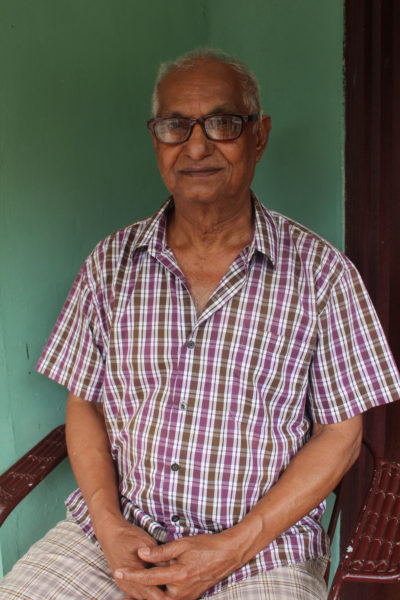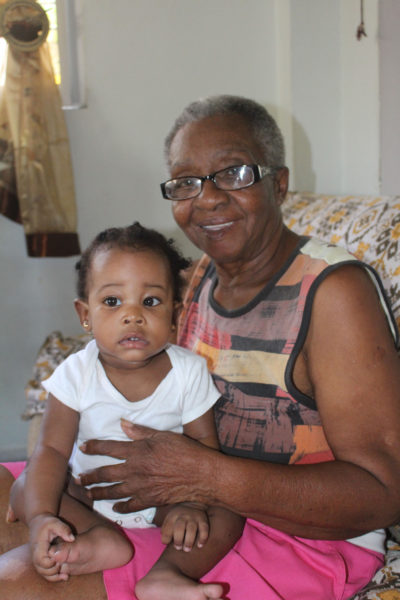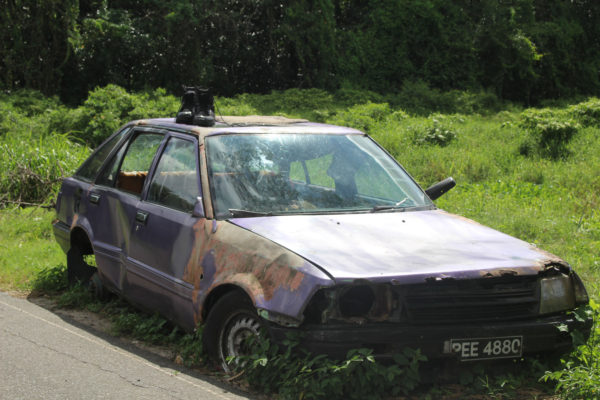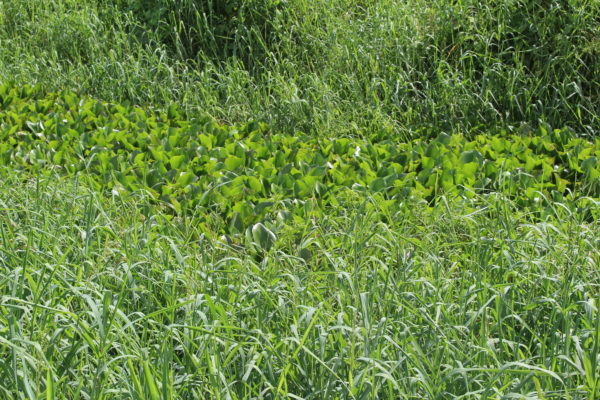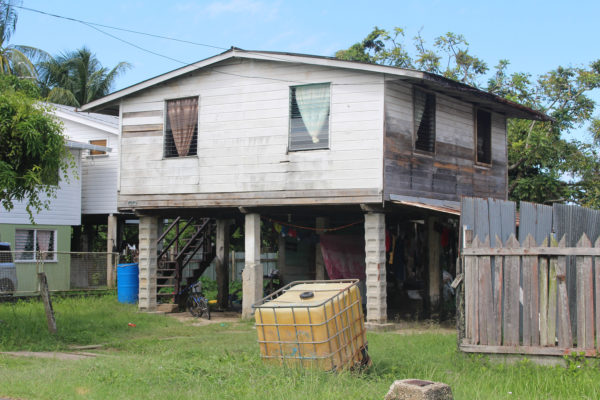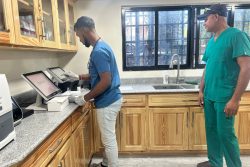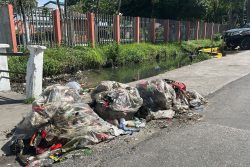A small community in the Klein/Pouderoyen area, Phoenix Park is home to approximately 300 residents.
Said to be the first cooperative self-help housing scheme in Guyana, the community once called ‘Crab Bush’ was officially opened in November, 1966; the Barrs were the very first family to live in the village.
A number of taxis are parked along the road, obliquely opposite the Klein/Pouderoyen Neighbourhood Democratic Council building, but the community is relatively quiet,
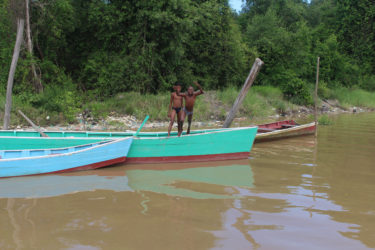
so much so that even before one reaches the last street of the village running parallel to the Demerara River, one can hear the birds and monkeys. Walking through the street, one can see mangroves growing so closely together that the river is hidden from view. A squirrel monkey commonly known as the sakiwinki swung from one of the hanging vines. Blue sakies and kiskadees flew between fruit trees planted by the road. A few cows and goats grazed guarded by some cranes, a pair of doves picked between the grass in a corner and dragonflies buzzed about.
Esther McGarrell, a lecturer at the Cyril Potter College of Education and the University of Guyana’s Institute of Distance and Continuing Education, had just ventured outside to check her letter box when we caught up with her. The former senior mistress of the West Demerara Secondary School, had done a documentary on the village some time ago. She was unable to find the documentation she had put together, but could still remember a lot.
Now 60, McGarrell moved to Phoenix Park 36 years ago when she got married, but did not have to fetch her trousseau far as she was living in a village called Coghlan Dam just opposite and growing up as a girl she had been quite familiar with the area, even before it came into existence. She recalled that Coghlan Dam was originally called “Phoenix Town” and that was where Phoenix Park got its name.
“All here was what we called ‘Crab Bush’. People from the villages around used come in and catch crabs,” she said. In fact the entire area was covered with mangroves.
“People had started living here before the official opening of the village… A man by the name of Basil King, a contractor, was the one who conceived the idea that here should become a housing scheme. It soon after became a self-help project, where persons who hadn’t house lots and had applied were allowed by the government to come and help build. Seventy five persons were chosen for house lots in Phoenix Park. Persons came and worked. The houses were two-bedroom… complete with electricity and potable water. They were all wooden houses built to look alike. At the end of the project, persons were given the opportunity of putting their hands in a bag and selecting a number to see which one of the 75 houses was theirs. It was the first cooperative self-help housing scheme in Guyana.”
McGarrell also shared a story many of the first settlers would have become familiar with, the tale of a dead woman roaming the streets at nights. According to McGarrell, Crab Bush was not only for catching crabs but for chopping wood, or as it was called then “picking wood” to use for firewood. McGarrell said she was only eight years old at the time, and was the friend of another little girl her age. The girl’s parents had a dispute around that time and it was rumoured that the wife was going to leave the husband. One day, the child’s mother went to Crab Bush to chop wood and when her father returned from work at the Versailles Estate, he too left with his cutlass for Crab Bush. They later found the mother chopped to pieces in the bush.
According to McGarrell, after the scheme was opened, many persons claimed to have seen the woman roaming the road, sometimes even opening their doors and seeing her on their doorsteps. McGarrell however has never had any such encounters.
“Most of the residents who live here are self-employed or government workers,” McGarrell said. “We have former head teachers, teachers, police officers, nurses, firemen, soldiers and a doctor living here; we have also Assistant Commissioner of Police, Maxine Graham.
“We have two churches; the Assemblies of God and another. The place is quiet. We get good access to potable water; which goes at one in the afternoons and return by 5 pm.
“However, I don’t like people that have their cows and goats on the loose; they’re eating the plants!
“I wish that the building we have for youths can be put to use. The last time I saw them making use of it was for the Jubilee celebrations. We can find skilled people to teach the young ones who don’t have the academic ability.”
Eighty-one-year-old Doreen Barr has been living in the village from the day it officially opened 50 years ago. Her family were the first residents that took up housing here. She moved from New Road, Vreed-en-Hoop with her husband Rudolph Barr, now 87 years old, who was one of the contractors, and five of their six children on November 1, 1966.
“We rented a place at Vreed-en-Hoop and hadn’t any electricity; we used gas lamps. I was so anxious to come here. We paid a down payment of $20 and $14 every month after that,” she recalled. She could not recall how long they had paid those instalments, but said she had heard rumours of persons wanting to pay in full with a lump sum, but not being allowed to do so.
“The mangroves on the sea dam weren’t there when we came here to live,” she reminisced. “You could’ve stand on the road and thrown a brick into the river. Sometimes I would be upstairs at my window and see the boats at the Georgetown Stelling. You could have even seen the [Stabroek] market clock, which was working at the time.”
She recalled that the house only had two rooms and a small kitchenette, “but thank God for it.” In time, she added, as families grew, people extended their homes.
Barr, a seamstress up to a few years ago sewed for customers in and out of her village. McGarrell, while growing up, was one of her customers, though at the time she did not yet live in the village. Barr also held classes for persons living in Phoenix Park and in villages close by and kept busy planting flower plants and cash crops. Today she still manages to plant her flowers.
“We have a problem with drainage here, although we don’t get flooding. The NDC takes care of the trench at the back probably once a year but it’s the little drains that some persons won’t clean. I’m hoping that persons clean the drains in front of their houses. If I clean my drain and my neighbours don’t clean theirs then they’re preventing mine from running out. I believe the NDC should insist on these persons cleaning their drains and serve notices,” she said.
Eighty-year-old Cruciverbalist Roy Paul, who creates crossword puzzles for the Sunday Stabroek, and is also the Kaieteur News’s ‘Uncle Roy’ was among the Phoenix Park pioneers.
“It was people who worked during the day that helped to build houses during the nights and on weekends. It took a little over a year to finish 75 houses, because most of the people who worked had little knowledge about carpentry,” he related. “The people who spearheaded the project were [the late] Basil King and [the late] Joseph Drakes. I was a teacher at the St Pius School in La Penitence and was renting a house in Pouderoyen. We’d come here at 4.30 in the afternoons and work until 9.30 in the evenings. There were quite a few women also who worked along with us. They would fetch tools for us and keep the bond.”
He said that the very first families to arrive here were the Barrs, the McGarrells, the Pauls, the Kings, the Robertses, and the Lopeses.
“There are more [African-Guyanese] living here than Indians. We had developed such good relationships among ourselves while building that although we put our hands in bags to pull a number we still approached the ministry to devise some plan to allow us to choose our neighbours. I had really good [Afro-Guyanese] friend that I made while working and I chose to live next to him.
“Racism wasn’t an issue then. We saw everyone as human beings. The older people still carry that same attitude but some of the younger ones pass you straight.”
Paul likes the idea of the community not being on the public road as that makes it safe for children.
“The good thing about having mangroves on the sea dam is that it prevents any breaking away of the dam,” he noted, “on the other hand it blocks the view of the river and the breeze.
“The mangroves breed sand flies and mosquitos terrible. I think we’re civilized in time to build a concrete structure for a [sea defence],” he added.
The village is separated from the sea dam by a 4ft trench, which Paul alleges has caimans. One morning he awoke to a five-foot caiman in his yard and called some friends who had it killed. He said he initially kept the skin hung on his door as a trophy but as it wasn’t cured it didn’t last long.
Concerning developments, Paul noted, “They build a youth centre in the middle of the village. I would like to see them making use of it in various ways; maybe finding a Phoenix Park Association so youngsters can play football or whatever to build on relationships. The Thursday between Christmas and New Years I organized a little get-together for the seniors. I did a little talk and we played bingo. It was well received. It would be nice to keep things like that going.”
